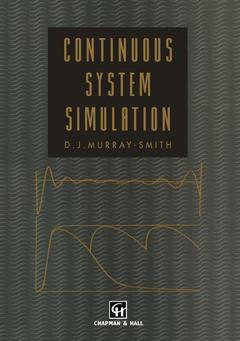Description
Continuous System Simulation, 1995
Author: Murray-Smith D.J.
Language: English
Subject for Continuous System Simulation:
Approximative price 52.74 €
In Print (Delivery period: 15 days).
Add to cart
Publication date: 11-2012
255 p. · 17.8x25.4 cm · Paperback
255 p. · 17.8x25.4 cm · Paperback
Description
/li>Contents
/li>
obtained by simulation more quickly, effec Computer simulation of dynamic systems is a topic which is growing steadily in importance tively and cheaply than by experimentation and testing of the real system. System perfor in the physical sciences, engineering, biology and medicine. The reasons for this trend mance can also be investigated using simula relate not only to the steadily increasing tion for a much wider range of conditions than can be contemplated for the real system power of computers and the rapidly falling costs of hardware, but also to the availability because of operating constraints or safety of appropriate software tools in the form of requirements. Similar factors can apply in simulation languages. Problem-oriented lan other fields, such as biomedical systems guages of this kind assist those who are not engineering. specialists in computational methods to trans System simulation, using digital computers, can relate either to models based on continu late a mathematical description into a simula tion program in a simple and straightforward ous variables or to discrete-event descriptions. fashion. They can also provide useful diag Continuous system simulation techniques are applied to systems described by sets of differ nostic information when difficulties are encountered. Therefore, a simulation lan ential equations and algebraic equations.
The principles of modelling. An introduction to simulation methods. Problem organisation for continuous system simulation. The principles of numerical modelling. Sampled-data models and operator methods. The principles of equation-oriented simulation software. The principles of block diagram-oriented simulation tools. Simple examples using common simulation tools. Internal verification and external validation. Case study I - a two-tank liquid level control system. Case study II - an aircraft automatic landing system. Case study III - respiratory gas-exchange process simulation. Case study IV - a simulation model of active skeletal muscle. Real-time simulation. Current trends in continuous system simulation. Appendices. Index.
© 2024 LAVOISIER S.A.S.

